Transition to Nursing Practice: Reflective Safe Medication Management
VerifiedAdded on 2023/04/23
|9
|2596
|52
Essay
AI Summary
This essay employs reflective practice to explore safe medication management during the transition to clinical nursing practice. It addresses challenges related to prioritizing patient care, medication management, intervention planning, time management, and decision-making. The discussion incorporates regulatory frameworks and governance underpinning the nursing profession, drawing on personal placement experiences and relevant research to devise strategies for a healthy transition as a graduate nurse. The essay highlights the importance of safe medication practices, guided by the Australian Commission on Safety and Quality in Healthcare guidelines and National Safety and Quality in Health Service Standards. It reflects on incidents involving potential medication errors, such as confusing look-alike, sound-alike (LASA) drugs and incorrect dosage administration, and proposes strategies like using Tall Man lettering and thorough medication reviews to enhance practice and ensure patient safety. The essay further emphasizes the role of clinical handovers, interdisciplinary coordination, and adherence to ethical codes and professional conduct standards in delivering safe and effective patient care.
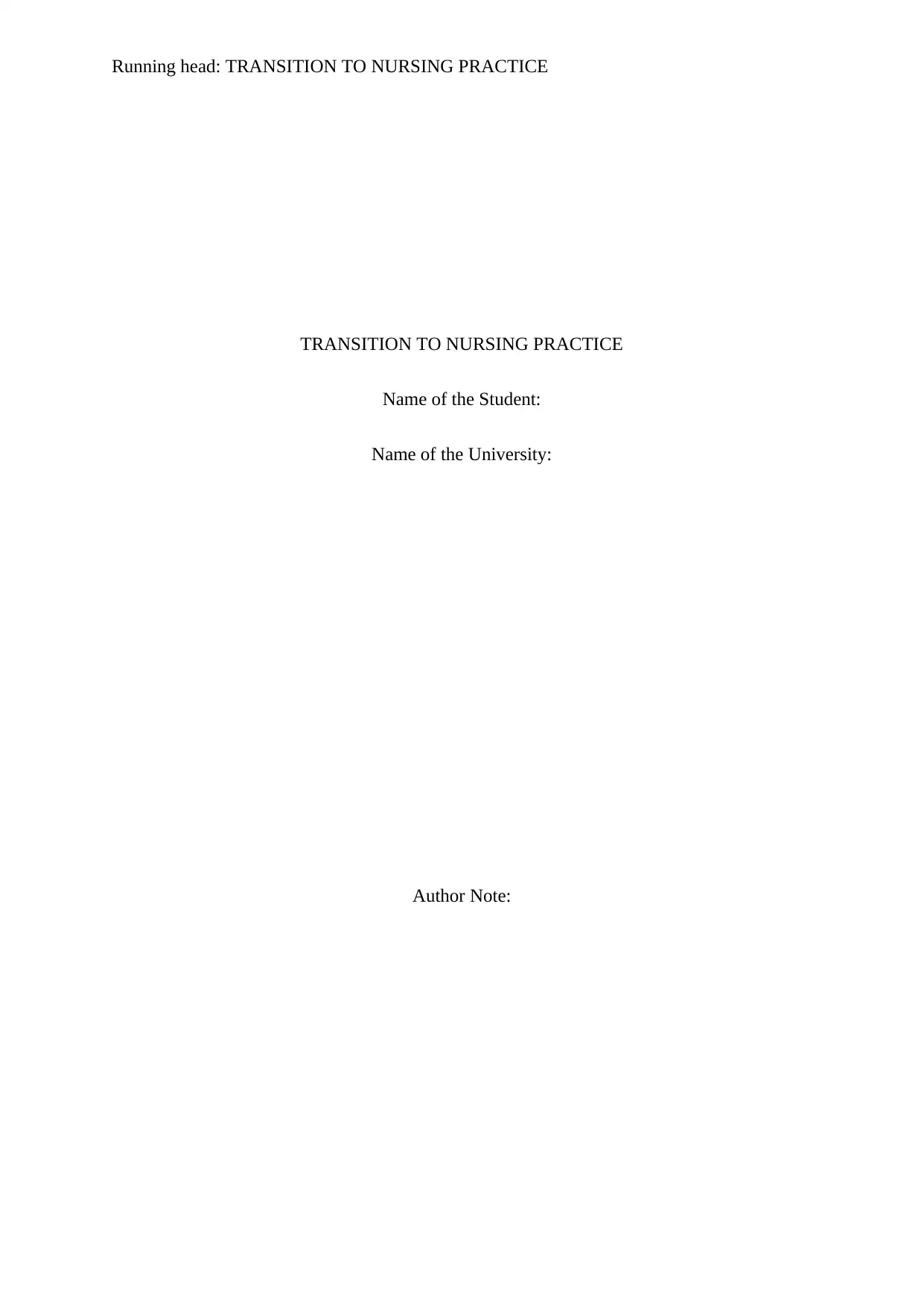
Running head: TRANSITION TO NURSING PRACTICE
TRANSITION TO NURSING PRACTICE
Name of the Student:
Name of the University:
Author Note:
TRANSITION TO NURSING PRACTICE
Name of the Student:
Name of the University:
Author Note:
Paraphrase This Document
Need a fresh take? Get an instant paraphrase of this document with our AI Paraphraser
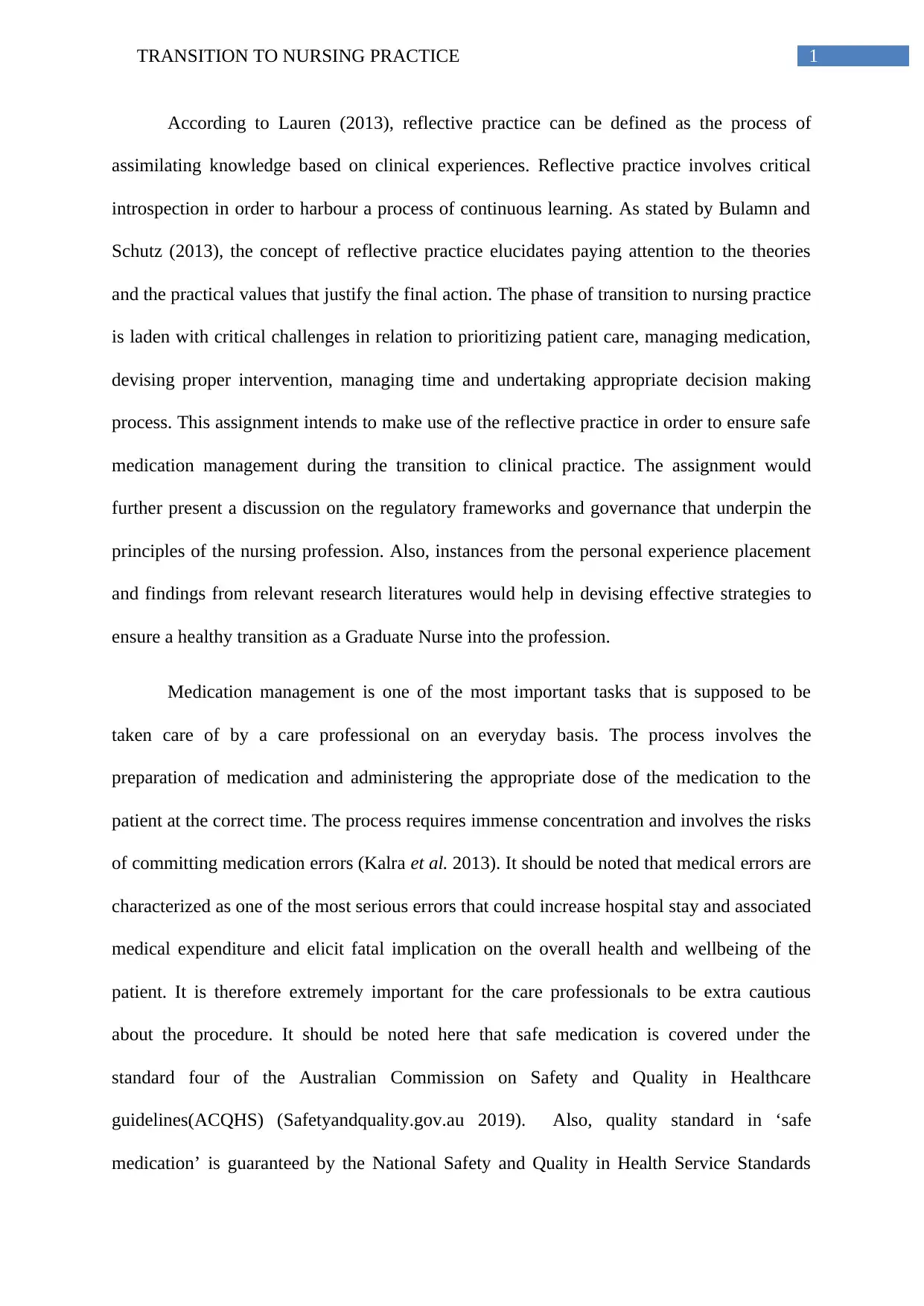
1TRANSITION TO NURSING PRACTICE
According to Lauren (2013), reflective practice can be defined as the process of
assimilating knowledge based on clinical experiences. Reflective practice involves critical
introspection in order to harbour a process of continuous learning. As stated by Bulamn and
Schutz (2013), the concept of reflective practice elucidates paying attention to the theories
and the practical values that justify the final action. The phase of transition to nursing practice
is laden with critical challenges in relation to prioritizing patient care, managing medication,
devising proper intervention, managing time and undertaking appropriate decision making
process. This assignment intends to make use of the reflective practice in order to ensure safe
medication management during the transition to clinical practice. The assignment would
further present a discussion on the regulatory frameworks and governance that underpin the
principles of the nursing profession. Also, instances from the personal experience placement
and findings from relevant research literatures would help in devising effective strategies to
ensure a healthy transition as a Graduate Nurse into the profession.
Medication management is one of the most important tasks that is supposed to be
taken care of by a care professional on an everyday basis. The process involves the
preparation of medication and administering the appropriate dose of the medication to the
patient at the correct time. The process requires immense concentration and involves the risks
of committing medication errors (Kalra et al. 2013). It should be noted that medical errors are
characterized as one of the most serious errors that could increase hospital stay and associated
medical expenditure and elicit fatal implication on the overall health and wellbeing of the
patient. It is therefore extremely important for the care professionals to be extra cautious
about the procedure. It should be noted here that safe medication is covered under the
standard four of the Australian Commission on Safety and Quality in Healthcare
guidelines(ACQHS) (Safetyandquality.gov.au 2019). Also, quality standard in ‘safe
medication’ is guaranteed by the National Safety and Quality in Health Service Standards
According to Lauren (2013), reflective practice can be defined as the process of
assimilating knowledge based on clinical experiences. Reflective practice involves critical
introspection in order to harbour a process of continuous learning. As stated by Bulamn and
Schutz (2013), the concept of reflective practice elucidates paying attention to the theories
and the practical values that justify the final action. The phase of transition to nursing practice
is laden with critical challenges in relation to prioritizing patient care, managing medication,
devising proper intervention, managing time and undertaking appropriate decision making
process. This assignment intends to make use of the reflective practice in order to ensure safe
medication management during the transition to clinical practice. The assignment would
further present a discussion on the regulatory frameworks and governance that underpin the
principles of the nursing profession. Also, instances from the personal experience placement
and findings from relevant research literatures would help in devising effective strategies to
ensure a healthy transition as a Graduate Nurse into the profession.
Medication management is one of the most important tasks that is supposed to be
taken care of by a care professional on an everyday basis. The process involves the
preparation of medication and administering the appropriate dose of the medication to the
patient at the correct time. The process requires immense concentration and involves the risks
of committing medication errors (Kalra et al. 2013). It should be noted that medical errors are
characterized as one of the most serious errors that could increase hospital stay and associated
medical expenditure and elicit fatal implication on the overall health and wellbeing of the
patient. It is therefore extremely important for the care professionals to be extra cautious
about the procedure. It should be noted here that safe medication is covered under the
standard four of the Australian Commission on Safety and Quality in Healthcare
guidelines(ACQHS) (Safetyandquality.gov.au 2019). Also, quality standard in ‘safe
medication’ is guaranteed by the National Safety and Quality in Health Service Standards
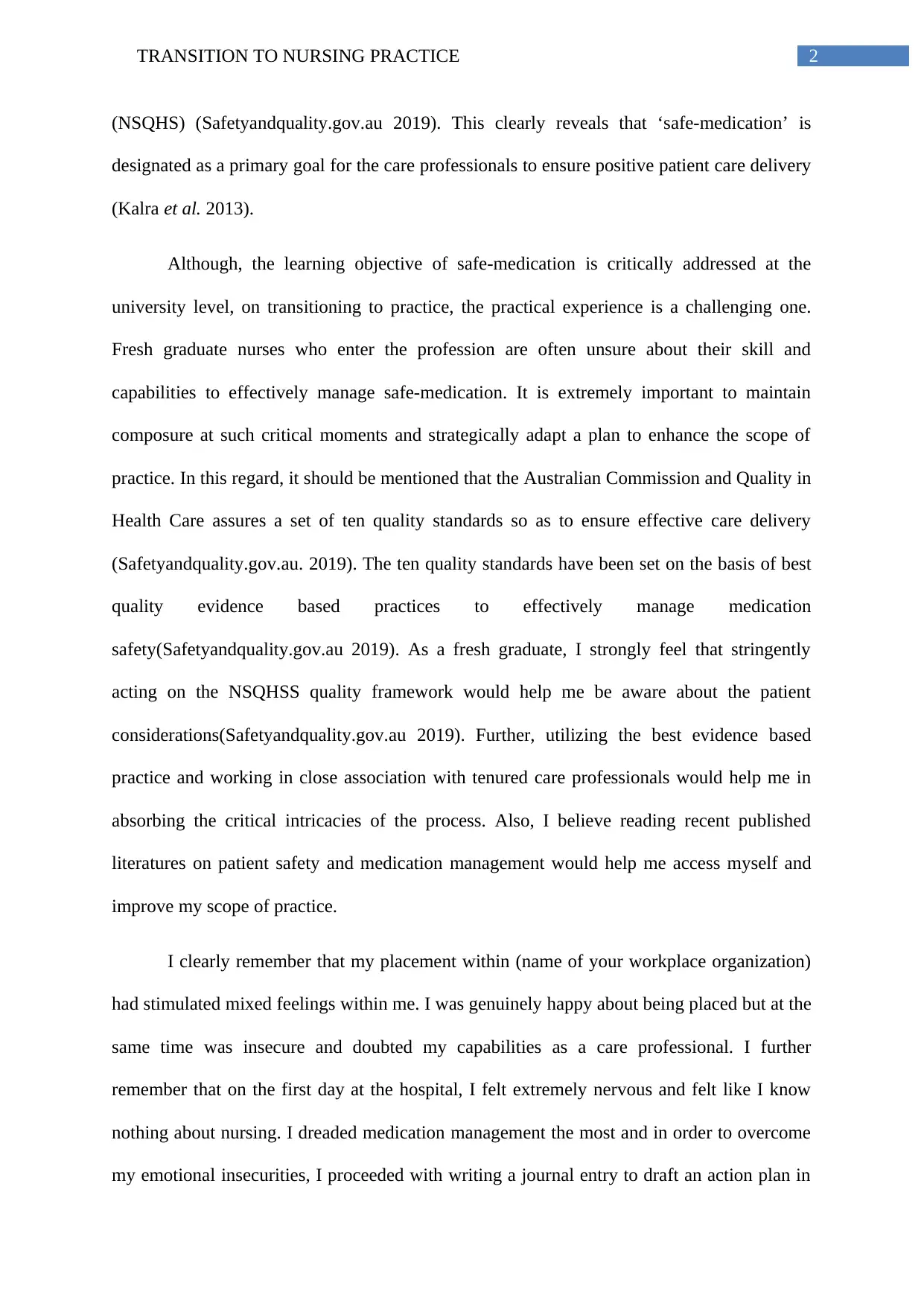
2TRANSITION TO NURSING PRACTICE
(NSQHS) (Safetyandquality.gov.au 2019). This clearly reveals that ‘safe-medication’ is
designated as a primary goal for the care professionals to ensure positive patient care delivery
(Kalra et al. 2013).
Although, the learning objective of safe-medication is critically addressed at the
university level, on transitioning to practice, the practical experience is a challenging one.
Fresh graduate nurses who enter the profession are often unsure about their skill and
capabilities to effectively manage safe-medication. It is extremely important to maintain
composure at such critical moments and strategically adapt a plan to enhance the scope of
practice. In this regard, it should be mentioned that the Australian Commission and Quality in
Health Care assures a set of ten quality standards so as to ensure effective care delivery
(Safetyandquality.gov.au. 2019). The ten quality standards have been set on the basis of best
quality evidence based practices to effectively manage medication
safety(Safetyandquality.gov.au 2019). As a fresh graduate, I strongly feel that stringently
acting on the NSQHSS quality framework would help me be aware about the patient
considerations(Safetyandquality.gov.au 2019). Further, utilizing the best evidence based
practice and working in close association with tenured care professionals would help me in
absorbing the critical intricacies of the process. Also, I believe reading recent published
literatures on patient safety and medication management would help me access myself and
improve my scope of practice.
I clearly remember that my placement within (name of your workplace organization)
had stimulated mixed feelings within me. I was genuinely happy about being placed but at the
same time was insecure and doubted my capabilities as a care professional. I further
remember that on the first day at the hospital, I felt extremely nervous and felt like I know
nothing about nursing. I dreaded medication management the most and in order to overcome
my emotional insecurities, I proceeded with writing a journal entry to draft an action plan in
(NSQHS) (Safetyandquality.gov.au 2019). This clearly reveals that ‘safe-medication’ is
designated as a primary goal for the care professionals to ensure positive patient care delivery
(Kalra et al. 2013).
Although, the learning objective of safe-medication is critically addressed at the
university level, on transitioning to practice, the practical experience is a challenging one.
Fresh graduate nurses who enter the profession are often unsure about their skill and
capabilities to effectively manage safe-medication. It is extremely important to maintain
composure at such critical moments and strategically adapt a plan to enhance the scope of
practice. In this regard, it should be mentioned that the Australian Commission and Quality in
Health Care assures a set of ten quality standards so as to ensure effective care delivery
(Safetyandquality.gov.au. 2019). The ten quality standards have been set on the basis of best
quality evidence based practices to effectively manage medication
safety(Safetyandquality.gov.au 2019). As a fresh graduate, I strongly feel that stringently
acting on the NSQHSS quality framework would help me be aware about the patient
considerations(Safetyandquality.gov.au 2019). Further, utilizing the best evidence based
practice and working in close association with tenured care professionals would help me in
absorbing the critical intricacies of the process. Also, I believe reading recent published
literatures on patient safety and medication management would help me access myself and
improve my scope of practice.
I clearly remember that my placement within (name of your workplace organization)
had stimulated mixed feelings within me. I was genuinely happy about being placed but at the
same time was insecure and doubted my capabilities as a care professional. I further
remember that on the first day at the hospital, I felt extremely nervous and felt like I know
nothing about nursing. I dreaded medication management the most and in order to overcome
my emotional insecurities, I proceeded with writing a journal entry to draft an action plan in
⊘ This is a preview!⊘
Do you want full access?
Subscribe today to unlock all pages.

Trusted by 1+ million students worldwide

3TRANSITION TO NURSING PRACTICE
order to work on my weakness. Prior to writing down the action plan, I decided to research
on the consequences of committing a medical error. It should be noted that the consequences
of committing a medical error invites strict disciplinary action which could also lead to
suspension or cancellation of the licensure to practice as a registered nurse
(Safetyandquality.gov.au. 2019). The problem was the lack of confidence to critically
undertake a decision and act independently so as to acquire positive outcome. At the initial
stage, unsupervised medication delivery is extremely challenging as there is a risk of
committing an error in relation to look alike and sound alike medication. In this regard, I
would like to mention one incident where I had mistakenly read Amittriptyline as
Aminophylline and was about to administer the wrong drug to the patient. The patient had to
be administered an antidepressant (Amittriptyline) and I was about to administer the drug
(Aminophylline) used for treating wheezing. This could elicit severe reaction in the patient
but fortunately the preceptor pointed out the mistake and prevented me from committing the
medication error. The preceptor thus helped me enhance my skills and render safe
medication, however dealing with look-alike and sound-alike medication still remains a
challenge for me.
Medical errors caused due to LASA drugs are common among fresh graduates and are
covered by the safety standard 4 of the CGHS guidelines. 40% of the medical errors are
attributed on account of the manhandling of LASA drugs (Osborn et al. 2013). The
prevention strategies to ideally avoid medical errors caused by LASA drugs would include
using Tall Man lettering. The technique involves differentiating between LASA drugs on the
basis of unique letter characters (Medscape 2019). It should be noted that the Tall Man
lettering system is a national standardised procedure that recommends the use of unique
letters or upper case letters to differentiate between LASA drugs that cause confusion and are
capable of causing fatal consequences (Safetyandquality.gov.au 2019).
order to work on my weakness. Prior to writing down the action plan, I decided to research
on the consequences of committing a medical error. It should be noted that the consequences
of committing a medical error invites strict disciplinary action which could also lead to
suspension or cancellation of the licensure to practice as a registered nurse
(Safetyandquality.gov.au. 2019). The problem was the lack of confidence to critically
undertake a decision and act independently so as to acquire positive outcome. At the initial
stage, unsupervised medication delivery is extremely challenging as there is a risk of
committing an error in relation to look alike and sound alike medication. In this regard, I
would like to mention one incident where I had mistakenly read Amittriptyline as
Aminophylline and was about to administer the wrong drug to the patient. The patient had to
be administered an antidepressant (Amittriptyline) and I was about to administer the drug
(Aminophylline) used for treating wheezing. This could elicit severe reaction in the patient
but fortunately the preceptor pointed out the mistake and prevented me from committing the
medication error. The preceptor thus helped me enhance my skills and render safe
medication, however dealing with look-alike and sound-alike medication still remains a
challenge for me.
Medical errors caused due to LASA drugs are common among fresh graduates and are
covered by the safety standard 4 of the CGHS guidelines. 40% of the medical errors are
attributed on account of the manhandling of LASA drugs (Osborn et al. 2013). The
prevention strategies to ideally avoid medical errors caused by LASA drugs would include
using Tall Man lettering. The technique involves differentiating between LASA drugs on the
basis of unique letter characters (Medscape 2019). It should be noted that the Tall Man
lettering system is a national standardised procedure that recommends the use of unique
letters or upper case letters to differentiate between LASA drugs that cause confusion and are
capable of causing fatal consequences (Safetyandquality.gov.au 2019).
Paraphrase This Document
Need a fresh take? Get an instant paraphrase of this document with our AI Paraphraser
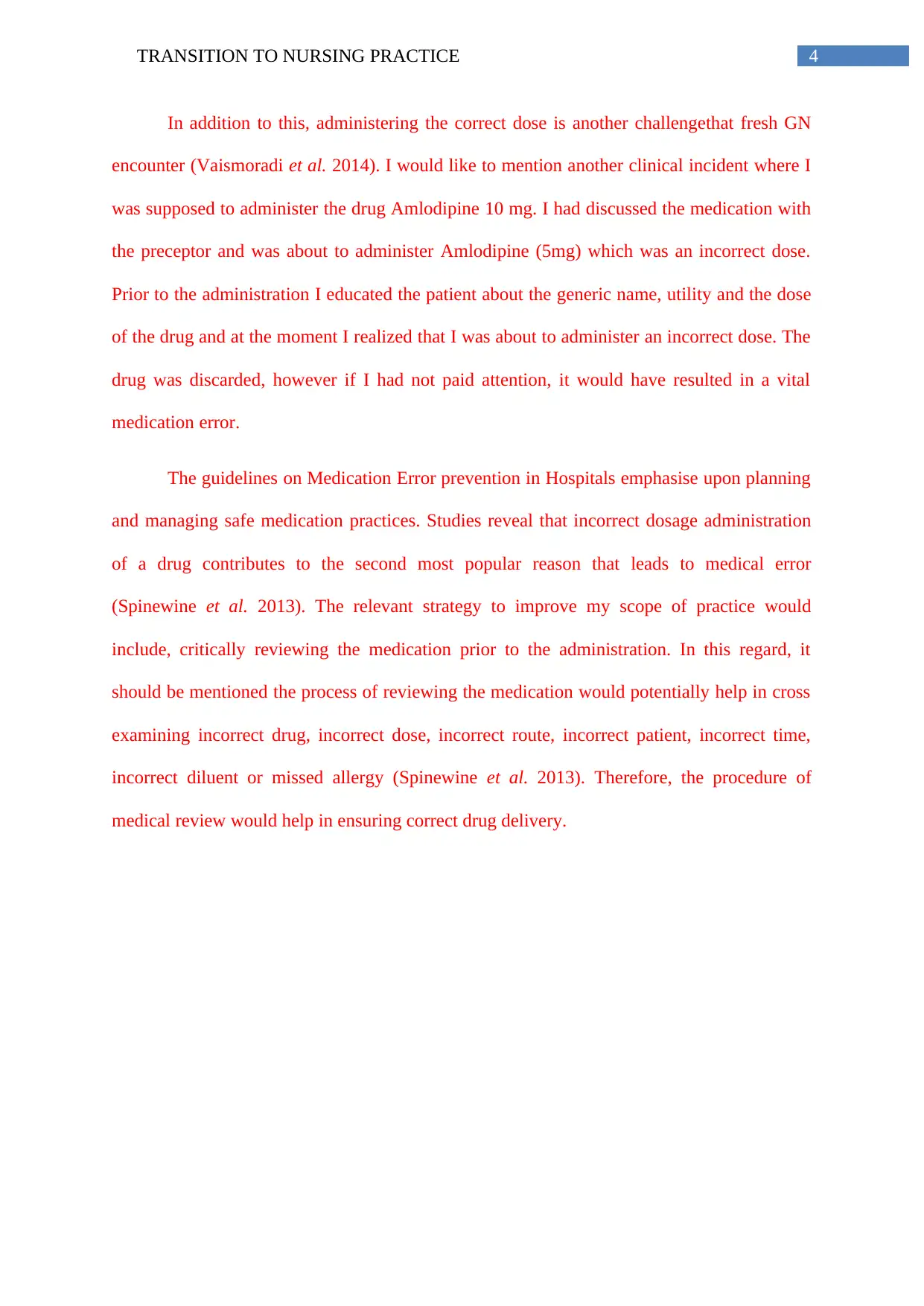
4TRANSITION TO NURSING PRACTICE
In addition to this, administering the correct dose is another challengethat fresh GN
encounter (Vaismoradi et al. 2014). I would like to mention another clinical incident where I
was supposed to administer the drug Amlodipine 10 mg. I had discussed the medication with
the preceptor and was about to administer Amlodipine (5mg) which was an incorrect dose.
Prior to the administration I educated the patient about the generic name, utility and the dose
of the drug and at the moment I realized that I was about to administer an incorrect dose. The
drug was discarded, however if I had not paid attention, it would have resulted in a vital
medication error.
The guidelines on Medication Error prevention in Hospitals emphasise upon planning
and managing safe medication practices. Studies reveal that incorrect dosage administration
of a drug contributes to the second most popular reason that leads to medical error
(Spinewine et al. 2013). The relevant strategy to improve my scope of practice would
include, critically reviewing the medication prior to the administration. In this regard, it
should be mentioned the process of reviewing the medication would potentially help in cross
examining incorrect drug, incorrect dose, incorrect route, incorrect patient, incorrect time,
incorrect diluent or missed allergy (Spinewine et al. 2013). Therefore, the procedure of
medical review would help in ensuring correct drug delivery.
In addition to this, administering the correct dose is another challengethat fresh GN
encounter (Vaismoradi et al. 2014). I would like to mention another clinical incident where I
was supposed to administer the drug Amlodipine 10 mg. I had discussed the medication with
the preceptor and was about to administer Amlodipine (5mg) which was an incorrect dose.
Prior to the administration I educated the patient about the generic name, utility and the dose
of the drug and at the moment I realized that I was about to administer an incorrect dose. The
drug was discarded, however if I had not paid attention, it would have resulted in a vital
medication error.
The guidelines on Medication Error prevention in Hospitals emphasise upon planning
and managing safe medication practices. Studies reveal that incorrect dosage administration
of a drug contributes to the second most popular reason that leads to medical error
(Spinewine et al. 2013). The relevant strategy to improve my scope of practice would
include, critically reviewing the medication prior to the administration. In this regard, it
should be mentioned the process of reviewing the medication would potentially help in cross
examining incorrect drug, incorrect dose, incorrect route, incorrect patient, incorrect time,
incorrect diluent or missed allergy (Spinewine et al. 2013). Therefore, the procedure of
medical review would help in ensuring correct drug delivery.
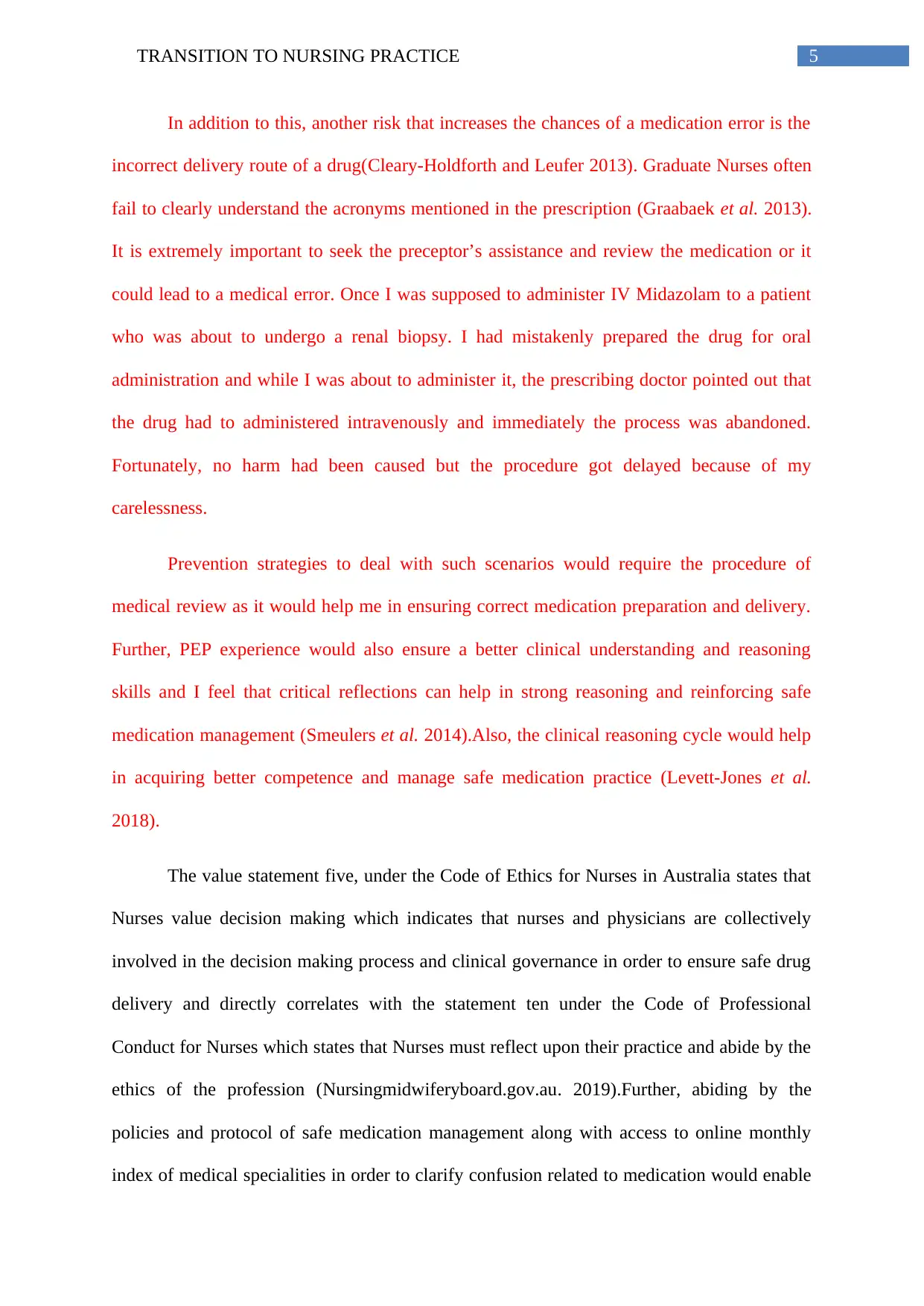
5TRANSITION TO NURSING PRACTICE
In addition to this, another risk that increases the chances of a medication error is the
incorrect delivery route of a drug(Cleary-Holdforth and Leufer 2013). Graduate Nurses often
fail to clearly understand the acronyms mentioned in the prescription (Graabaek et al. 2013).
It is extremely important to seek the preceptor’s assistance and review the medication or it
could lead to a medical error. Once I was supposed to administer IV Midazolam to a patient
who was about to undergo a renal biopsy. I had mistakenly prepared the drug for oral
administration and while I was about to administer it, the prescribing doctor pointed out that
the drug had to administered intravenously and immediately the process was abandoned.
Fortunately, no harm had been caused but the procedure got delayed because of my
carelessness.
Prevention strategies to deal with such scenarios would require the procedure of
medical review as it would help me in ensuring correct medication preparation and delivery.
Further, PEP experience would also ensure a better clinical understanding and reasoning
skills and I feel that critical reflections can help in strong reasoning and reinforcing safe
medication management (Smeulers et al. 2014).Also, the clinical reasoning cycle would help
in acquiring better competence and manage safe medication practice (Levett-Jones et al.
2018).
The value statement five, under the Code of Ethics for Nurses in Australia states that
Nurses value decision making which indicates that nurses and physicians are collectively
involved in the decision making process and clinical governance in order to ensure safe drug
delivery and directly correlates with the statement ten under the Code of Professional
Conduct for Nurses which states that Nurses must reflect upon their practice and abide by the
ethics of the profession (Nursingmidwiferyboard.gov.au. 2019).Further, abiding by the
policies and protocol of safe medication management along with access to online monthly
index of medical specialities in order to clarify confusion related to medication would enable
In addition to this, another risk that increases the chances of a medication error is the
incorrect delivery route of a drug(Cleary-Holdforth and Leufer 2013). Graduate Nurses often
fail to clearly understand the acronyms mentioned in the prescription (Graabaek et al. 2013).
It is extremely important to seek the preceptor’s assistance and review the medication or it
could lead to a medical error. Once I was supposed to administer IV Midazolam to a patient
who was about to undergo a renal biopsy. I had mistakenly prepared the drug for oral
administration and while I was about to administer it, the prescribing doctor pointed out that
the drug had to administered intravenously and immediately the process was abandoned.
Fortunately, no harm had been caused but the procedure got delayed because of my
carelessness.
Prevention strategies to deal with such scenarios would require the procedure of
medical review as it would help me in ensuring correct medication preparation and delivery.
Further, PEP experience would also ensure a better clinical understanding and reasoning
skills and I feel that critical reflections can help in strong reasoning and reinforcing safe
medication management (Smeulers et al. 2014).Also, the clinical reasoning cycle would help
in acquiring better competence and manage safe medication practice (Levett-Jones et al.
2018).
The value statement five, under the Code of Ethics for Nurses in Australia states that
Nurses value decision making which indicates that nurses and physicians are collectively
involved in the decision making process and clinical governance in order to ensure safe drug
delivery and directly correlates with the statement ten under the Code of Professional
Conduct for Nurses which states that Nurses must reflect upon their practice and abide by the
ethics of the profession (Nursingmidwiferyboard.gov.au. 2019).Further, abiding by the
policies and protocol of safe medication management along with access to online monthly
index of medical specialities in order to clarify confusion related to medication would enable
⊘ This is a preview!⊘
Do you want full access?
Subscribe today to unlock all pages.

Trusted by 1+ million students worldwide

6TRANSITION TO NURSING PRACTICE
safer practice (User 2019). Clinical handovers or ISBAR form an integral aspect of fostering
patient care and managing medication. I would ensure that the progress notes that I transfer to
other nurses are correctly written in order to avoid the chances of conducting a medical error.
Also, on not being clear about the progress notes or patient assessment I would proactively
consult with my fellow colleagues so to ensure correct intervention. In addition to this, cross-
evaluating medication charts to identify possible issues with non-administered medication,
ceased medication or unsigned medication would help in abiding by the quality standard five
and six of the NSQHSS standards that include patient identification and matching procedure
and managing clinical handover and ensuring right of medication administration
(Nursingmidwiferyboard.gov.au 2019). Finally, prioritizing patient care and maintaining a
coordination between the interdisciplinary healthcare departments would help in delivering
safe medication practice (Westbrook et al. 2013).
Therefore, my action plan would comprise of complying with all the above mentioned
strategies in order to overcome my insecurities and acquire confidence to safely manage
medication. In addition to this self-governance, delegation along with critical reflection
would help me in acquiring competence to manage safe medication practice. The statement
one and two of the CPCN state that nursing professionals must comply with the standard of
the profession and uphold the mission and vision of the organization they are placed in to
render effective patient care. I would therefore abide by the governance frameworks and
policies to impart quality in terms of care delivery.
safer practice (User 2019). Clinical handovers or ISBAR form an integral aspect of fostering
patient care and managing medication. I would ensure that the progress notes that I transfer to
other nurses are correctly written in order to avoid the chances of conducting a medical error.
Also, on not being clear about the progress notes or patient assessment I would proactively
consult with my fellow colleagues so to ensure correct intervention. In addition to this, cross-
evaluating medication charts to identify possible issues with non-administered medication,
ceased medication or unsigned medication would help in abiding by the quality standard five
and six of the NSQHSS standards that include patient identification and matching procedure
and managing clinical handover and ensuring right of medication administration
(Nursingmidwiferyboard.gov.au 2019). Finally, prioritizing patient care and maintaining a
coordination between the interdisciplinary healthcare departments would help in delivering
safe medication practice (Westbrook et al. 2013).
Therefore, my action plan would comprise of complying with all the above mentioned
strategies in order to overcome my insecurities and acquire confidence to safely manage
medication. In addition to this self-governance, delegation along with critical reflection
would help me in acquiring competence to manage safe medication practice. The statement
one and two of the CPCN state that nursing professionals must comply with the standard of
the profession and uphold the mission and vision of the organization they are placed in to
render effective patient care. I would therefore abide by the governance frameworks and
policies to impart quality in terms of care delivery.
Paraphrase This Document
Need a fresh take? Get an instant paraphrase of this document with our AI Paraphraser
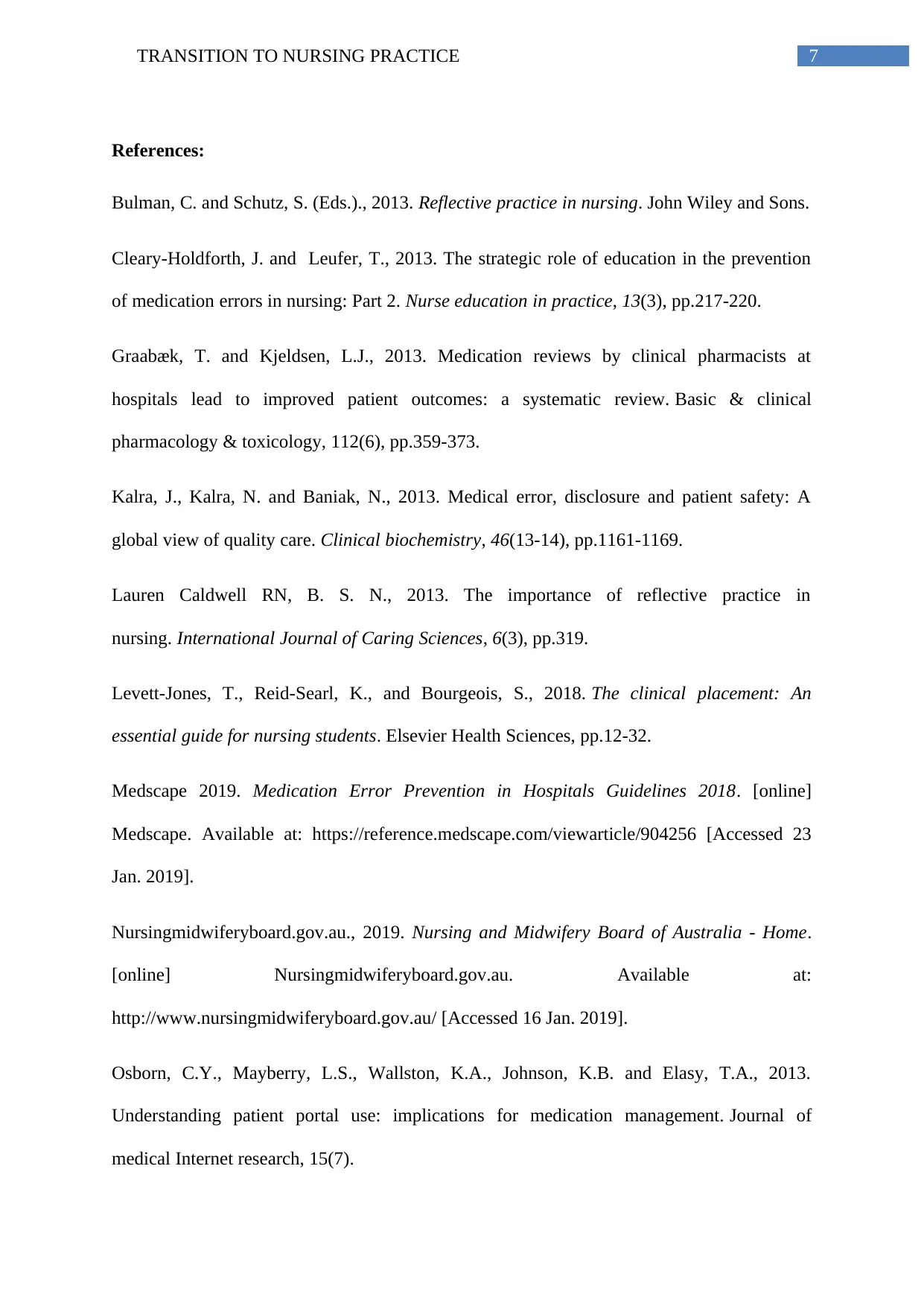
7TRANSITION TO NURSING PRACTICE
References:
Bulman, C. and Schutz, S. (Eds.)., 2013. Reflective practice in nursing. John Wiley and Sons.
Cleary-Holdforth, J. and Leufer, T., 2013. The strategic role of education in the prevention
of medication errors in nursing: Part 2. Nurse education in practice, 13(3), pp.217-220.
Graabæk, T. and Kjeldsen, L.J., 2013. Medication reviews by clinical pharmacists at
hospitals lead to improved patient outcomes: a systematic review. Basic & clinical
pharmacology & toxicology, 112(6), pp.359-373.
Kalra, J., Kalra, N. and Baniak, N., 2013. Medical error, disclosure and patient safety: A
global view of quality care. Clinical biochemistry, 46(13-14), pp.1161-1169.
Lauren Caldwell RN, B. S. N., 2013. The importance of reflective practice in
nursing. International Journal of Caring Sciences, 6(3), pp.319.
Levett-Jones, T., Reid-Searl, K., and Bourgeois, S., 2018. The clinical placement: An
essential guide for nursing students. Elsevier Health Sciences, pp.12-32.
Medscape 2019. Medication Error Prevention in Hospitals Guidelines 2018. [online]
Medscape. Available at: https://reference.medscape.com/viewarticle/904256 [Accessed 23
Jan. 2019].
Nursingmidwiferyboard.gov.au., 2019. Nursing and Midwifery Board of Australia - Home.
[online] Nursingmidwiferyboard.gov.au. Available at:
http://www.nursingmidwiferyboard.gov.au/ [Accessed 16 Jan. 2019].
Osborn, C.Y., Mayberry, L.S., Wallston, K.A., Johnson, K.B. and Elasy, T.A., 2013.
Understanding patient portal use: implications for medication management. Journal of
medical Internet research, 15(7).
References:
Bulman, C. and Schutz, S. (Eds.)., 2013. Reflective practice in nursing. John Wiley and Sons.
Cleary-Holdforth, J. and Leufer, T., 2013. The strategic role of education in the prevention
of medication errors in nursing: Part 2. Nurse education in practice, 13(3), pp.217-220.
Graabæk, T. and Kjeldsen, L.J., 2013. Medication reviews by clinical pharmacists at
hospitals lead to improved patient outcomes: a systematic review. Basic & clinical
pharmacology & toxicology, 112(6), pp.359-373.
Kalra, J., Kalra, N. and Baniak, N., 2013. Medical error, disclosure and patient safety: A
global view of quality care. Clinical biochemistry, 46(13-14), pp.1161-1169.
Lauren Caldwell RN, B. S. N., 2013. The importance of reflective practice in
nursing. International Journal of Caring Sciences, 6(3), pp.319.
Levett-Jones, T., Reid-Searl, K., and Bourgeois, S., 2018. The clinical placement: An
essential guide for nursing students. Elsevier Health Sciences, pp.12-32.
Medscape 2019. Medication Error Prevention in Hospitals Guidelines 2018. [online]
Medscape. Available at: https://reference.medscape.com/viewarticle/904256 [Accessed 23
Jan. 2019].
Nursingmidwiferyboard.gov.au., 2019. Nursing and Midwifery Board of Australia - Home.
[online] Nursingmidwiferyboard.gov.au. Available at:
http://www.nursingmidwiferyboard.gov.au/ [Accessed 16 Jan. 2019].
Osborn, C.Y., Mayberry, L.S., Wallston, K.A., Johnson, K.B. and Elasy, T.A., 2013.
Understanding patient portal use: implications for medication management. Journal of
medical Internet research, 15(7).
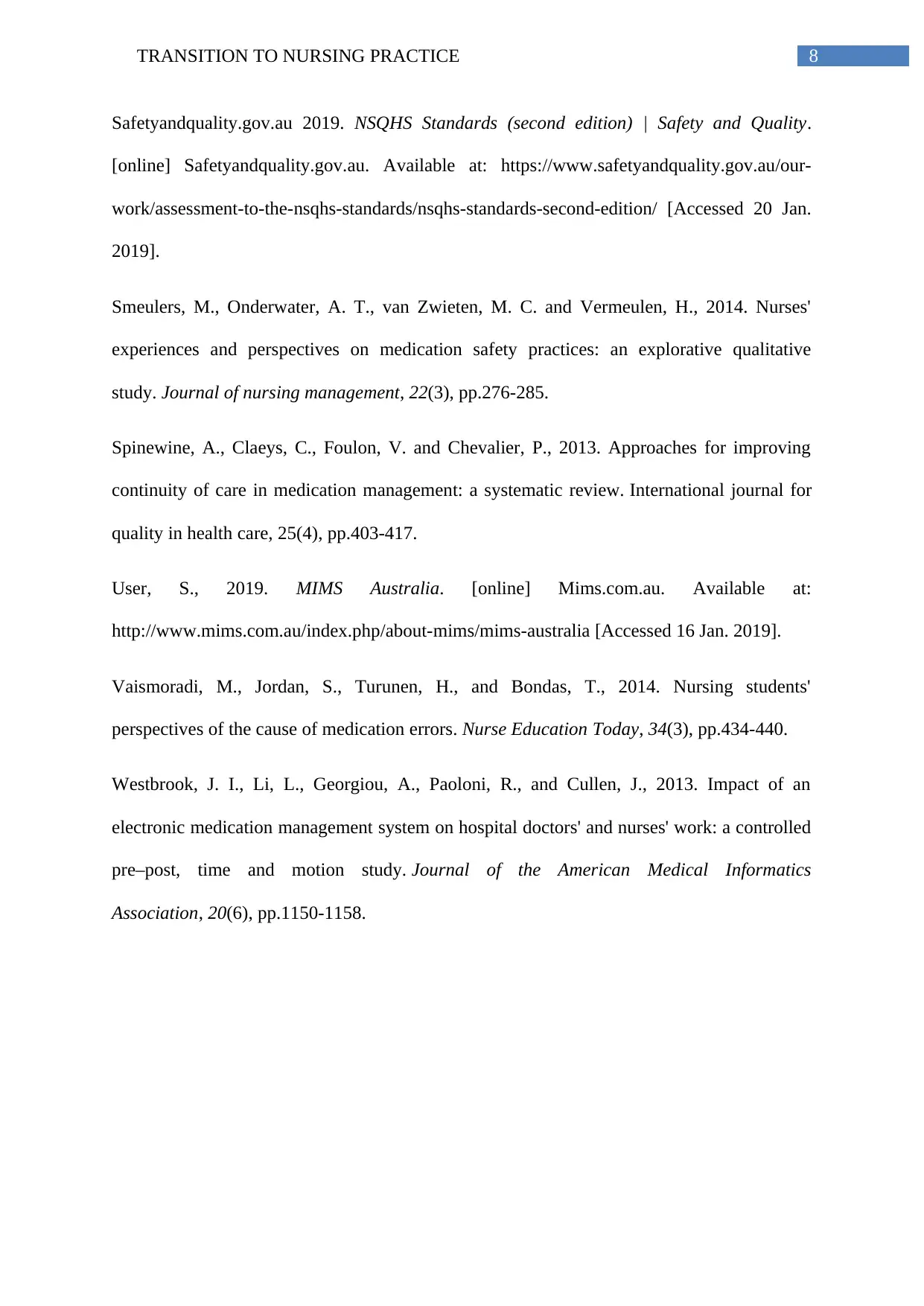
8TRANSITION TO NURSING PRACTICE
Safetyandquality.gov.au 2019. NSQHS Standards (second edition) | Safety and Quality.
[online] Safetyandquality.gov.au. Available at: https://www.safetyandquality.gov.au/our-
work/assessment-to-the-nsqhs-standards/nsqhs-standards-second-edition/ [Accessed 20 Jan.
2019].
Smeulers, M., Onderwater, A. T., van Zwieten, M. C. and Vermeulen, H., 2014. Nurses'
experiences and perspectives on medication safety practices: an explorative qualitative
study. Journal of nursing management, 22(3), pp.276-285.
Spinewine, A., Claeys, C., Foulon, V. and Chevalier, P., 2013. Approaches for improving
continuity of care in medication management: a systematic review. International journal for
quality in health care, 25(4), pp.403-417.
User, S., 2019. MIMS Australia. [online] Mims.com.au. Available at:
http://www.mims.com.au/index.php/about-mims/mims-australia [Accessed 16 Jan. 2019].
Vaismoradi, M., Jordan, S., Turunen, H., and Bondas, T., 2014. Nursing students'
perspectives of the cause of medication errors. Nurse Education Today, 34(3), pp.434-440.
Westbrook, J. I., Li, L., Georgiou, A., Paoloni, R., and Cullen, J., 2013. Impact of an
electronic medication management system on hospital doctors' and nurses' work: a controlled
pre–post, time and motion study. Journal of the American Medical Informatics
Association, 20(6), pp.1150-1158.
Safetyandquality.gov.au 2019. NSQHS Standards (second edition) | Safety and Quality.
[online] Safetyandquality.gov.au. Available at: https://www.safetyandquality.gov.au/our-
work/assessment-to-the-nsqhs-standards/nsqhs-standards-second-edition/ [Accessed 20 Jan.
2019].
Smeulers, M., Onderwater, A. T., van Zwieten, M. C. and Vermeulen, H., 2014. Nurses'
experiences and perspectives on medication safety practices: an explorative qualitative
study. Journal of nursing management, 22(3), pp.276-285.
Spinewine, A., Claeys, C., Foulon, V. and Chevalier, P., 2013. Approaches for improving
continuity of care in medication management: a systematic review. International journal for
quality in health care, 25(4), pp.403-417.
User, S., 2019. MIMS Australia. [online] Mims.com.au. Available at:
http://www.mims.com.au/index.php/about-mims/mims-australia [Accessed 16 Jan. 2019].
Vaismoradi, M., Jordan, S., Turunen, H., and Bondas, T., 2014. Nursing students'
perspectives of the cause of medication errors. Nurse Education Today, 34(3), pp.434-440.
Westbrook, J. I., Li, L., Georgiou, A., Paoloni, R., and Cullen, J., 2013. Impact of an
electronic medication management system on hospital doctors' and nurses' work: a controlled
pre–post, time and motion study. Journal of the American Medical Informatics
Association, 20(6), pp.1150-1158.
⊘ This is a preview!⊘
Do you want full access?
Subscribe today to unlock all pages.

Trusted by 1+ million students worldwide
1 out of 9
Related Documents
Your All-in-One AI-Powered Toolkit for Academic Success.
+13062052269
info@desklib.com
Available 24*7 on WhatsApp / Email
![[object Object]](/_next/static/media/star-bottom.7253800d.svg)
Unlock your academic potential
Copyright © 2020–2025 A2Z Services. All Rights Reserved. Developed and managed by ZUCOL.





